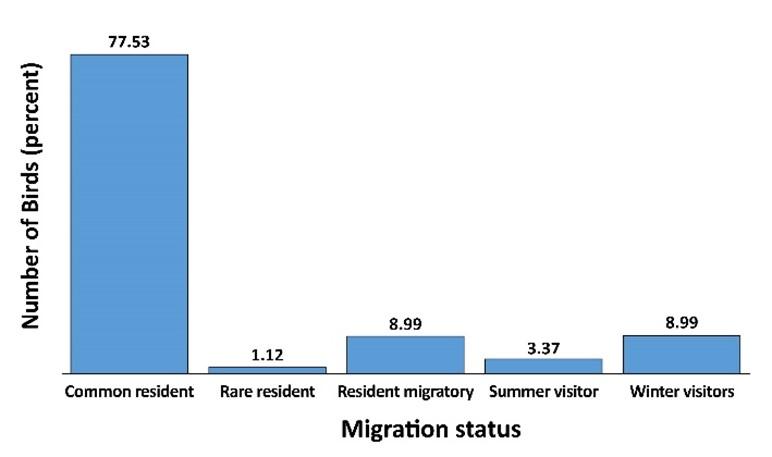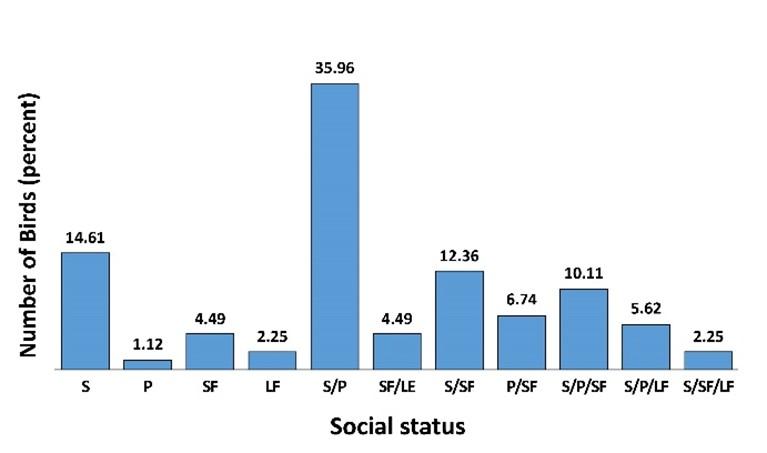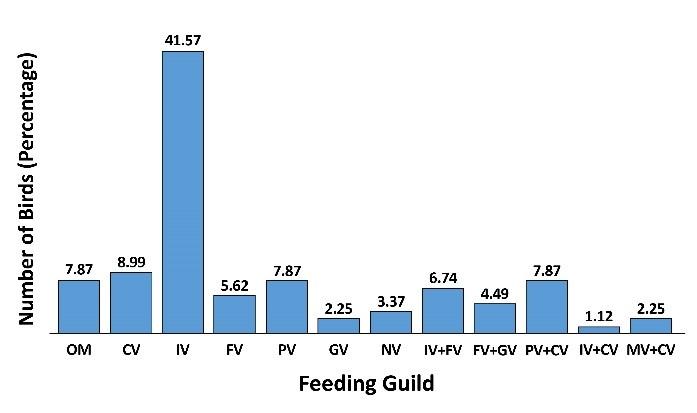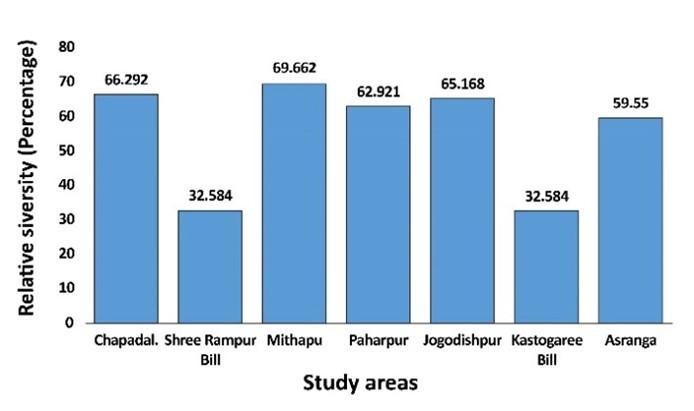Habit and habitual status with relative diversity study of avifauna of Jaipurhat district of Bangladesh
Abstract
This investigation was carried out to observe the migration status and the feeding guild of the avian fauna including the relative diversity of Jaipurhat district of Bangladesh. Data were collected from November 2017 to October 2019. During the study period, 89 avian species were recorded that belong to 32 families under 11 orders among which 8 (8.99%) species were common winter visitors, 3 (3.37%) were common summer visitors, 8 (8.99%) were resident migratory, 1 (1.12%) were rare resident and 69 (77.53%) were resident birds. Among the birds observed in the study area during the study period the highest number of birds was found to be insectivorous (41.57%), then the carnivorous (8.99%), then omnivorous, piscivorous and picio carnivorous (7.87%), then insecto frugivorous (6.67%), then frugivorous (5.62%), then frugio graminivorous (4.49%), then nectarivorous (3.39%), then graminivorous and molluscio carnivorous (2.25%) and insecto carnivorous (1.12%). The hight avian diversity (69.662%) was observed in Mithapur which is human inhabited area with crop lands and a lot of fruit trees and the lowest (32.584%) diversity was in Shree Rampur Bill and Kastogari Bill which has large water bodies. This study will be helpful to understand the status of birds in different season in the study area.
INTRODUCTION
Zoo geographically Bangladesh is located at the Indo- Malayan and Indo- China sub region of the Oriental region and for this bio geographical location Bangladesh acts as a corridor of wildlife among the neighboring countries, India, Myanmar and Bhutan. Bangladesh is famous for its avian diversity. This country shelters a lot of resident birds and a lot of migratory birds come to this country both in summer and winter for food and shelter. Birds are common dwellers of any ecosystem and very important ecological indicator as well. Diversity of avifauna is one of the most important ecological indicators to evaluate the quality of habitats [1]. In any type of ecosystem, avian fauna constitutes one of the major biotic components [2]. Birds play significant ecological roles like pollination, seed dispersion, maintaining ecological balance etc. The rich avian diversity indicates a healthy ecosystem.
A recent census of birds, informed that being a biodiversity hotspot Bangladesh harbors 690 species of birds [3], which is 7% of the world total species of 9,600 (MFA compiled, unpublished report). Published regional avifauna of Bangladesh are found in literature viz., Islam [4] from Rangpur District; Husain [5, 6] from Chittagong Hill Tracts and Pablakhali Wildlife Sanctuary; Banerjee [7] and Das [8] from Curzan Hall area of the University of Dhaka and the Ramna Park of Dhaka respectively; Das [8] from Sylhet District; Sarker & Sarker [9] from the Sundarbans, Haque & Rahman [10] from the Ramna Park and Suhrawardy Uddyan, Dhaka; Akhter [11] from the Boldha Garden, Dhaka; Sarker et al. [12] from the Moheshkhali Island; Reza et al. [13] from Rajshahi University Campus; and Reza et al. [14] from the Padma Charlands near Rajshahi City, etc. Sarkar [15] published seabirds of the Bay of Bengal of Bangladesh Coast and their conservation; Jaman et al. [16, 17] studied ecology, conservation problems and status of avifauna of Noakhali Charbata Coastal area. Sarker et al. [18, 19] reported diversity of avifauna of Bagkhali Range and Cox’s Bazar; Sarker et al. [20] reported the avifauna from two urban sites of the Uttara Model Town, Dhaka. Literature on the avian diversity are very scanty from the Rajshahi region. Haque [21] published a list of birds from the Rajshahi University campus, which was later updated by Reza et al. [13]. Karmakar et al. [22] published an article on birds of Joypurhat District. Reza et al. [14], Reza & Parween [23] reported on the waterbirds of the Padma River and the migratory birds of the Padma River Charlands, Hasan et al. [24] published an article on birds of Shoipara Beel of Mohanpur Upazilla, Rajshahi District and Amin & Hasan reported on the birds of Naogaon District respectively [25]. This study will illustrate the status of birds of the study area.
MATERIALS AND METHODS
Study area
Joypurhat is a District of Rajshahi Division that has an area of 965.44 sq. km. It is bounded by Dinajpur in the north, Naogaon in the south, and Bogra and Gaibandha in the east, Bogra and Naogaon and West Bengal, India in the west [33]. For the convenience of the field work, the study area was divided into seven sites follows: Chapadal, Shree Rampur Bill, Mithapur, Paharpur, Jogodishpur, Kastogaree bill and Asranga (site A, B, C, D, E, F and G). The study area might be differentiated into two major groups.
Bill areas
Shree Rampur Bill (site B) and Kastogari Bill (site F) has large water body with thin human houses and wide agricultural lands.
Human locality
Chapadal (site A), Mithapur (site C), Paharpur (site D), Jogodishpur (site E) and Asranga (site G) were human inhabited areas with villages, small ponds, lots of fruit trees and agricultural lands.
Study period
The study was carried out from November 2017 to October 2019.
Study design
The study was carried out whole the year round. Specially, during three seasons i.e. Rainy (July to October), winter (November to February) and summer (March to June) seasons, birds were observed by regular visits (At least 8 days in a month). Look and see method was opted for bird’s survey.
Data collection techniques
Field data of birds were observed during winter season at morning hours between 6.30 to 9.00 a.m. and in the evening from 4.00 to 6.00 p.m., during summer season at morning hours between 5.00 to 8.00 a.m. and evening from 5.00 to 7.00 p.m. while, during the rainy season at morning hours between 6.00 to 8.30 a.m. and evening from 4.30 to 6.30 p.m. All types’ of habitats were surveyed carefully for birds. The area was visited by walking; sometimes small boat was used to cover the wetland areas. The birds were observed with binoculars (Bushnell 20 × 200 mm with multicoated lens) and photographed using digital cameras (Nikon P 530).
Identification of birds
The birds were identified from their photographs in the Central library, Seminar library and with the help of the book Name of Bangladesh birds: prespective written by Professor Dr. Aminuzzaman Saleh Reza, Department of Zoology, University of Rajshahi. Also consulted literatures for bird identification were Ali and Ripley [26], Ali [27], Khan [3, 28], Halder [29], Grewal [30].
Migration status
The birds were categorized according to their status at the study area, which are Common Resident (R), Rare Resident (RR), Resident Migratory (RM), Migratory, summer visitors (MSV) and Migratory, Winter Visitors (MWV).
Social status
The status of the resting or foraging types were studied. Some birds were found to rest or forage either solitary or in pair or in small parties. The water birds were found to forage mostly in different sized family flocks or in mixed species flocks. The symbols for the social status of the birds are used as S (solitary/single), P (pair), F (flock), LF (large flock), and SF (small flock),
Feeding guild
Feeding habits of the observed birds were studied. The bird species were identified accordingly their feeding guild. The feeding guilds were categorized as frugivorous (FV), carnivorous (CV), nectivorous (NV), molluscivorous (MV), piscivorous (PV), granivorous (GV), insectivorous (IV) and Omnivorous (OM).
Statistical analysis
Systematic lists were constructed following Ali and Ripley (1996) [26] to yield Relative Diversity (RD):
Relative abundance was assessed as ‘very common’ (seen on 75–100% of visits), ‘common’ (seen on 50–74% of visits), ‘uncommon’ (seen on 25–49% of visits), and ‘rare’ (seen on <25% of visits).
RESULTS
Species diversity
A total of 89 species of birds were recorded from the study area. A check list of birds found in the Jaipurhat District is given in Table 1. Distribution, abundance of birds in different blocks, local status, social status and feeding guild and IUCN status of birds are represented in Table 2. Number and percentages of families and species under each order and Relative abundance of bird species under each family is given in Table 3. Among the total 89 species only one (Ichthyophaga ichthyaetus) is globally threatened [31]. The observed species are representatives of 11 orders and 32 families.
Table 1. Checklist of the birds found in Jaipurhat district.
Table 2. Distribution, abundance of birds in different blocks, local status, social status and feeding guild and IUCN status.
Table 3. Number and percentages of families and species under each Order and Relative abundance of bird species under each family.
Migration status
Among the 89 species of birds 8 (8.99%) species were common winter visitors, 3 (3.37%) were common summer visitors, 8 (8.99%) were resident migratory, 1 (1.12%) were rare resident and 69 (77.53%) were resident birds (Table 2, Figure 1). Among the birds listed in this area, the most common winter visitors were Fulvous whistling duck (Dendrocygna bicolor), Lesser whistling-duck (Dendrocygna javanica), Common Snipe (Gallinago gallinago), Common Swallow (Hirundo rustica), White-Browed Wagtail (Motacilla maderaspatensis), White Wagtail (Motacilla alba), Yellow Wagtail (Motacilla flava) and Tickell’s Leaf wabler (Dicaeum cruenatum); summer visitors were Blue-tailed Bea-Eater (Merops philippinus), Pied Cuckoo (Clamator jacobinus) and Common Hawk Cuckoo (Hierococcyx varius). Grey-Headed fish eagle (Ichthyophaga ichthyaetus) was seen in this study area as well which is considered as a rear resident bird that is a globally threatened at present time according to IUCN. Night Heron (Nycticorax nycticorax), Great Egret (Casmerodicus albus), Asian openbill (Anastomus oscitans), Little Cormorant (Phalacrocorsx carbo), Jungle Crow (Corvus macrorhynchos) and Ashy Drongo (Dicrurus leucophaeus) were seen periodically because of their resident migratory habit. The rest were seen all years around.

Social status
Birds are different in social status as well as their feeding status. Sometime they are found in solitary or in pairs. Some birds are formed small to large groups. Some birds are visited in a small to large or loose flocks. The number of species found as single (solitary) was 13 (14.61%), paired 1 (1.12%) and may single or in pairs was 32 (35.96%). However, 4 (4.49%) species were found in small flock and 2 (2.25%) were found in large flock. Some birds were found in single or small flocks, some were found in paired or small flock while some were seen in small or large flocks and the numbers of these groups of birds are 11 (12.36%), 6 (6.74%) and 4 (4.49%) respectively. About 9 (10.11%) birds were seen in single, paired or forming small flocks; 5 (5.62%) were single, paired or in large flocks, and 2 (2.25%) bird species were seen single or formed both small and large flocks. All these statuses are shown in Table 2 and Figure 2.

Feeding guild
The guild-wise percentages of the 89 species are shown in Figure 3. Among the species 41.57% were insectivorous, followed by omnivorous 7.87%, carnivorous 8.99%, fruityvorous 5.62%, piscivorous 7.87%, nectarivorous 3.37% and graminivorous 2.25%. Some species has also intermediate feeding guild such as picivorous-carnivorous 7.87% and insectivorous-fruityvorous 6.74%, frugivorous-graminivorous 4.49%, insectivorous-carnivorous 1.12% and molluscivorous-carnivorous 2.25%.

Relative diversity of birds on the basis of different study sites
Bird diversity and dispersion depends on the habitat and availability of the food sources. For example aquatic birds like duck, cormorant etc. are very common near water bodies, fruit eaters are seen in trees usually, and grain eaters love to forage in the crop fields. The study area was divided into seven sites under two major habitat, bill area and human locality. The relative diversity of birds on the basis of different study sites is given in figure 4. Bird diversity was found higher in human locality than the bill areas. In Mithapur the highest bird diversity was observed (69.622%), then in Chapadal (66.292%), then in Jogodishpur (65.168%), then in Asranga (59.55%). The lowest diversity was observed in Shree Rampur Bill and Kastogaree Bill (32.584%)

DISCUSSION
During this study period 89 bird species were observed that are the representatives of 11 orders and 32 families which support the findings of Karmakar et al. [22]. According to Siddiqui et al [32] there are a total 650 species of birds found in the Bangladesh territory, among which 477 are regular species. Out of these regular species 301 are residents of the country and 176 are seasonal migrants. The number of winter migrants is 160, summer migrants are 6 and spacing or passage migrants are 10. Based on relative abundance of birds 143 are vagrants, 176 are rare, 103 are uncommon and 198 are common species of Bangladesh [3, 28 and 32]. Among the birds of Bangladesh IUCN declared 40 species as globally threatened. But Rhett A. Butler mentioned only 607 birds are present and 36 are threatened in Bangladesh in ‘‘Total Number of Bird Species by Country’’ at July 1, 2019 [35]. The avifauna of Jaipurhat District enlists total 89 species which is 13.69% of the Bangladeshi species. The study area includes Small River, marsh land, wetland, cropland, village groves and orchards along with some fallow lands. During this study birds have been recorded 8.99% common winter visitors, 3.37% common summer visitors, 8.99% resident migratory, 1.12% were rare resident and 77.53% resident birds among the total amount of birds.
In this study according to social status the findings was that the highest number of bird species as single or in pairs 35.96% ; others followed by 14.61% solitary, 1.12% paired, small flock 4.49%, large flock 2.25% , single or small flocks 12.36%, paired or small flock 6.74%, small or large flocks 4.49% respectively. About 10.11% birds were seen in single, paired or forming small flocks; 5.62% were single, paired or in large flocks, and 2.25% bird species were seen single or formed both small and large flocks. And according to feeding guild the highest number of bird species as insectivorous 41.57% and lowest number of bird species as insectivorous-carnivorous 1.12% were recorded. Bird diversity was found higher in human locality than the bill areas. In Mithapur the highest bird diversity was observed (69.622%), then in Chapadal (66.292%), then in Jogodishpur (65.168%), then in Asranga (59.55%). The lowest diversity was observed in Shree Rampur Bill and Kastogaree Bill (32.584%).
ACKNOWLEDGEMENTS
The authors are grateful to the Chairman, Department of Zoology, University of Rajshahi for providing necessary facilities to accomplish the research work and to Dr. Nurul Islam and Dr. Aminuzzaman Mohammad Saleh Reza for their guidance. The founding sponsors had no role in the design of the study; in the collection, analyses, or interpretation of data; in the writing of the manuscript, and in the decision to publish the results.
AUTHOR CONTRIBUTIONS
AA and KH were involved in conception and design of the experiments. AA, KH, SM, MA, SS and SA contributed to perform the experiments. AA, KH and SM analyzed data. SS contributed to drafting the article. KH and MA contributed to revising it critically for important intellectual content. AA made the final approval of the version to be published.
CONFLICTS OF INTEREST
Authors declared that they have no conflict of interest.
References
- [1]Sarkar NJ, Sultana D, Jaman MF, Rahman MK. Diversity and population of Avifauna of Two Urban States in Dhaka, Bangladesh. Ecological society, Nepal. 2009; 16: 1-7.
- [2]Dhindas MS, Saini HK. Avian Fauna of Wetlands. Unpublished thesis, Department of Zoology, Punjab Agriculture Univesity, Ludhiana, Pakistan. 1994.
- [3]Khan MAR. Bangladesher Pakhi (Birds of Bangladesh). Bangla Academy, Dhaka, Bangladesh. 2008.
- [4]Islam MT. Birds of Rangpur (with notes on taxonomy, food and relationships). M.Sc. Thesis (Unpublished). University of Dhaka. 1969.
- [5]Husain KZ. Field notes on the birds of the Chittagong Hill Tract. J. Asiat. Soc. Pakistan. 1969; 13(1): 91-101.
- [6]Husain KZ. Birds of the Pablakhali Wildlife Sanctuary. Bangladesh J. Zool. 1975; 3(2): 145-155.
- [7]Banerjee RK. Status and composition of avifauna of the Curzon Hall Campus and Ramna Park, Dhaka. M. Sc. thesis, Department of Zoology, University of Dhaka, Bangladesh. 1978.
- [8]Das SR. Birds of Sylhet. M. Sc. thesis, Department of Zoology, University of Dhaka, Bangladesh. 1975.
- [9]Sarker SU and Sarker, NJ. Status and distribution of birds of the Sundarbans. J. Noami.1986; 3(1): 19-37.
- [10]Haque NM and Rahman MK. Birds of the Ramna and Suhrawardy Parks. Published jointly by the Wildlife Society of Bangladesh (WSB) and Bangladesh Bird Preservation Society (BBPS). 1993.
- [11]Akter S. The wildlife of Boldha garden, Dhaka, Bangladesh (with notes on ecology, habitat and present status). M. Sc. thesis, Department of Zoology, University of Dhaka, Bangladesh. 1997.
- [12]Sarker SU, Jaman MF, Hossain ML and Sarker NJ. Wildlife diversity of Moheskhali Island: Their ecology and conservation issues. J. Noami. 2001; 18(1): 17-31.
- [13]Reza AMS, Hossain MM, Hasan MA and Parween S. Anotated checklist of birds of Rajshahi University Campus: An update. j. zool. Rajshahi Univ. 2012; 31: 39-47.
- [14]Reza AMS, Al-Amin M, Rahman SMA, Hasan MS, Islam MS and Parween, S. A checklist of waterbirds of the Padma river charland (Godagari to Charghat), Rajshahi, Bangladesh. Univ. j. zool., Rajshahi Univ. 2014; 33: 19-23.
- [15]Sarker SU. Seabirds of the Bay of Bengal off Bangladesh coast and their conservation. Tiger Paper. 1984; 11(4): 9-13.
- [16]Jaman MF and Sahreen N. Ecology and breeding biology of Chestnut-tailed starling, Sturnus malabaricus (Gmellin 1789). Ecoprint. 2004; 11(1): 27-34.
- [17]Jaman MF, Haque MSZ, and Sarker SU. Ecology, conservation problems and status of avifauna of Noakhali Charbata Coastal area. J. Noam. 2004; 21(1): 1-13.
- [18]Sarker SU, Jaman MF, Sarker NJ and Hossain ML. Status of wildlife of St. Martin Island, Bangladesh. Dhaka Univ. J. Biol. Sci. 2000; 9(1): 75-85.
- [19]Sarker SU, Jaman MF, Sarker NJ and Rahman MK. Diversity of avifauna in Bagkhali range, Cox’s Bazar forest division. Bangladesh Environ. 2000; 230-238.
- [20]Sarkar NJ, Sultana D, Firoj JM and Rahman MK. Diversity and population of avifauna of two urban sites in Dhaka, Bangladesh. Ecoprint. 2009; 16: 1-7.
- [21]Haque AKMF. Birds of the Rajshahi University Campus. Bangladesh J. Zool. 1976; 4(2): 125127.
- [22]Karmakar S, Parween S and Reza AMS. Birds of Joypurhat District, Bangladesh. J. Life & Earth Sci. 2011; 6: 51-57.
- [23]Reza AMS and Parween S. A preliminary list of the migratory birds of the Padma Charland, Rajshahi. Jahangirnagar University J. Biol. Sci. 2014; 3(2): 85-92.
- [24]Hasan K, Das BC, Parween S and Reza AMS. Avian diversity of the shoipara beel of mohanpur upazilla, rajshahi, bangladesh. J. Life Earth Science. 2017; 12: 21-27.
- [25]Amin A and Hasan K. A checklist and relative diversity of avifauna of Atrai, Raninagar and Naogan Sadar Upazillas of Naogaon district of Bangladesh. International Journal of Zoology Studies. 2019. 3(2): 38-45.
- [26]Ali S and Ripley SD. Handbook of the birds of India and Pakistan, 1. Bombay: Oxford University Press. 1996, pp 266.
- [27]Ali S. The Book of Indian Birds. Oxford University Press. 2002, pp 466.
- [28]Khan MAR. Wildlife of Bangladesh: Checklist-cum-Guide. Chayabithi, Dhaka, Bangladesh. 2015.
- [29]Halder RR. A Photographic Guide to Birds of Bangladesh. Baikal Teal Production; 1st 2010, pp 257.
- [30]Grewal B, Sujoy M and Wright G. Birds of India, Pakistan, Bangladesh, Nepal & Shri Lanka: A photographic guide. Guidebook Company Ltd. New Delhi, India. 1993.
- [31]IUCN, Red Data Book of Threatened Birds of Bangladesh. The World Conservation Union, Dhaka, Bangladesh. 2000.
- [32]Siddiqui NA, Shahidullah M and Shahjalal MAH. An overview of diversity, trends and threats of birds. Indian J. Forestry. 2008; 14(2): 17-45.
- [33]Banglapedia 2003. National Encyclopedia. Asiatic Society of Bangladesh, Dhaka. 9: 470-474.
- [34]Banglapedia 2015; http://en.banglapedia.org/index.php?title=Bird.
- [35]Rhett AB. Total number of birds species by country. ©Mongabay 1995-2020. 2019. https://rainforests.mongabay.com/03birds.htm#content.